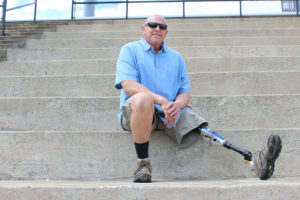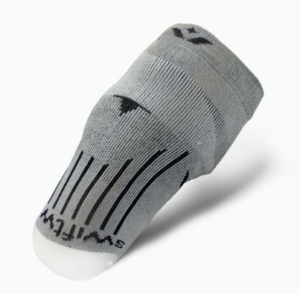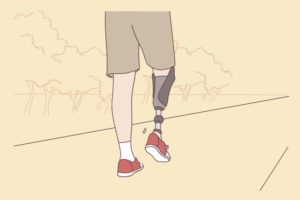Living With Prosthetics
 Prosthetics have come a long way since they were first introduced.
Prosthetics have come a long way since they were first introduced.
There is now a range of highly technical, advanced prostheses on the market with 3D printing ensuring a more accurate design and fit; making more life-like and flexible solutions commonplace.
A beneficiary survey, combined with feedback from HNAs, reveals that 9.5% (44) of beneficiaries currently use prosthetics. Leg and ear prosthetics are the most used, with a very small number of people still using prosthetic arms.
Getting the right prosthesis can be a challenge for the Thalidomide community. The uniqueness of your disability, and the shape and nature of your stump (if you are limb affected), may mean that your options are different to those of the general population accessing prosthesis services.
We shed some light on the services available and how to get the best out of them, with some useful insights from your own experiences.
A look at prosthetics
Getting a prosthetic of any kind is a life-changing process.
As beneficiaries tell us, the prospect can be daunting, especially if it involves invasive surgery, but the benefits can be amazing.
In Kim’s case, the procedure for having a prosthetic ear seemed difficult, scary and overwhelming, but the benefits far outweighed those initial worries. For Glenn, a new style prosthetic leg has made a huge difference to his quality of life.
If you’ve been living with prostheses for most of your life, they become part of you. You can almost forget that they are there; until they become uncomfortable, or even painful.
There are lots of reasons why your limb might feel different, or no longer the right fit. Don’t just live with it; asking yourself the right questions can help you get the solutions you need and the comfort you deserve.
Follow these tips for a comfortable life with prosthetics: -
 Ask the important questions
Ask the important questions
How long have I had my prosthetic?
If you can’t remember, it must be a pretty long time. Like anything else, prosthetics succumb to wear and tear. If it has worn out it may need repairing – or even replacing.
How well is it functioning?
Why did you get your prosthetic in the first place? Are you still using it for the same things you needed it for when you first had it fitted? Do you still need these functions or is there something else you need?
Your needs may have changed in all sorts of ways, over time. Perhaps you are no longer working; or have become more active, doing things like walking, swimming or playing golf. You may be wearing different clothes, or have a new hairstyle, that expose more of your prosthesis. Maybe you’re traveling abroad and need something that’s easier to manage, and lighter to transport.
If your requirements from your limb change – tell your limb fitter.
Has my body changed?
Changes to your body are definitely going to affect how a prosthetic limb feels.
Weight loss or gain, illness, the changes ageing makes to bone density and muscle tissue, increased physical activities; all of these will impact on the fit and comfort of your limb and may cause pain or result in an ill-fitting socket, it’s important to make your limb fitter aware of any changes.
Work with your limb fitter and get regular check-ups
Having a good, ongoing relationship with your limb fitter, and being able to communicate with them about your prosthetic is crucial.
Mark has had a fantastic relationship with his limb fitters over the years. It has allowed him to use the old-style prosthetic leg (which he is happy with) and adapt it to his changing needs.
Even if you think you don’t need to, attend your regular check-ups with your limb fitting service. Your prosthesis might need some light maintenance or tweaks to keep it in tip top condition; and it will also help you keep the lines of communication open with the service.
If you aren’t routinely offered a check-up, DO ask for one, especially if you haven’t had one for a long time.
Outside of your check-ups, if something is no longer working, or uncomfortable, contact your limb fitting service to let them know, and book an appointment to see them.
If you have any problems establishing a relationship with your limb fitter, or accessing the service, please let the Trust know so that a member of the Health & Wellbeing team can help you.
Go with the service that suits you best
 NHS v Private
NHS v Private
It’s important to recognise that the NHS in your local area may not be able to offer you what you need.
Unfortunately, NHS services don’t all provide the same types of prosthetics; local NHS Clinical Commissioning Groups (CCGs) each decide how to spend their budget based on local demand – and this includes prosthetics.
That’s why you might find that the type of prosthetic you have been offered might differ to what another beneficiary has been offered, in a different part of the country.
You do have the choice to access another NHS service outside your local area, but you’ll need to consider how far you would have to travel for your fittings and reviews; and the impact it may have on you.
Remember, you aren’t just limited to NHS services
There are a number of private prosthetic services across the country. Although they may seem expensive, they offer a much wider range and often more advanced types of prosthesis, that could have a huge impact on your day-to-day life.
Jane (not her real name) has first-hand experience of using a private service. She had explored all the possible options available from her NHS service, but they could not give her the quality of life she deserved, free from pain. We suggested seeing what was available privately to meet Jane’s needs and it has led to the most fantastic outcome.
Beneficiary recommendations
A beneficiary who wears prosthetics has recommended the ‘Stump Sock’ from Swiftwick. Their advice is to request a pair from the Limb Centre first, try them and then buy.
The VALOR® Below Knee Prosthetic Sock for Amputees is specifically designed to fit limbs with amputations below the knee. Worn against the skin, underneath liners, for improved comfort and performance. The VALOR® Below Knee sock is the ultimate moisture management solution with a Linked Seam that creates a smooth distal end for maximum comfort.

Find further information on these useful websites
BLESMA - British Limbless Ex-Serviceman's Association
Contact Us
If you have questions, concerns or information and experiences to share contact the Health & Wellbeing team on 01480 474074 or email. We’re happy to help.




